
Listen to this example
So, can one drummer play in two time signatures simultaneously? Yes... and no. Here's a little exercise consisting of a fairly simple groove in 5/4 time that can be played with just the right hand and right foot (it feels a bit like the Beatles song Ticket To Ride). Above it, I've done a really simple 3/4 subdivision on the hi-hat and hi tom-tom that can be played with the left hand (actually, in the audio sample I'm playing the left hand on a jam block and the hi-hat). As you can see, you have to play five measures of 3/4 and 3 measures of 5/4 before they fall together on "one" again. I'm sure you can imagine that after playing this a bit, you could start to move the right hand around on various toms and maybe you could start to add some syncopation to the left hand figure.
Now, look at this exercise again. I could actualy write that as just three measures of 5/4 with a shifting accent. So that begs the question: is this really a polyrhythm? Again, the answer appears to be yes and no. Forgive me if I'm a bit ambiguous on that. It's not quite the same as playing 5:3 (described in an earlier post), but it's not all that different either. If I played the 5/4 part on the drums and had a bass player play the 3/4 part, I would definitely write it out as two seperate time signitures and call it a polyrhythm. But the way I wrote it above is really just to make clear what's going on. If I were actually going to write that groove as a drum part, I would most likely write it as three measures of 5/4 with shifting accent (by the way, even with 5:3 or 3:2 we still need the figure to be in the context of a specific time signiture in order to figure out what's going on.). So here it is written in just 5/4, but I've hi-lighted the first beat of each group of 3 in one color and the first beat of each group of 5 in another color.


Interesting, eh? Now let's take a look at the 5:3 polyrhythm that I described earlier and see if there's some similarity.

Obviously, there's a great deal of similarity. In fact, the 5/4 vs. 3/4 concept will probably help you understand the 5:3 concept. In the 5:3 tuplet example the five would be spread across three beats. In the 5/4 vs 3/4 measure the five are distributed across three meaures.
I have run across the word polymeter used to distinguish between this and tuplet based figures. I don't know if this is common usage or not, again it seems to be kind of a grey area. None the less, because tuplets require specialized notation (5:3) and the other really does not, I think it's good to have some way to distinguish between the two. So unless a higher authority comes along to correct me, I'm going to use the terms Polyrhythm and Polymeter as similar but different terms. At the same time, in general usage, I'll probably consider both to be polyrhythms.


1 comment:
I think I've done something sort of similar with a riff I've written before. I'm not a drummer. I'm a guitarist, and I'm just now kind of getting into non-4/4 time signatures as I've only been playing for about 4 years. On my Myspace profile I have a riff called "Polyrhythm"...I'm not sure if I've named it properly, seeing as how my pianist friend told me she thought it was more like Polymeter. I googled it and stumbled upon this blog. But...is my riff sort of the same concept you're talking about? It's basically a 4/4 whole note backing rhythm behind a riff in...7/8? I suppose. I didn't know how to resolve them evenly, so I just tossed a few extra 8th notes on the end. I'm guessing I probably could've played it 3 more times? This stuff is so confusing. I'm just trying to find some clarity as to what I should call this stuff. I'm going to try to experiment with it and use it with more complexity in songs and such.
Post a Comment